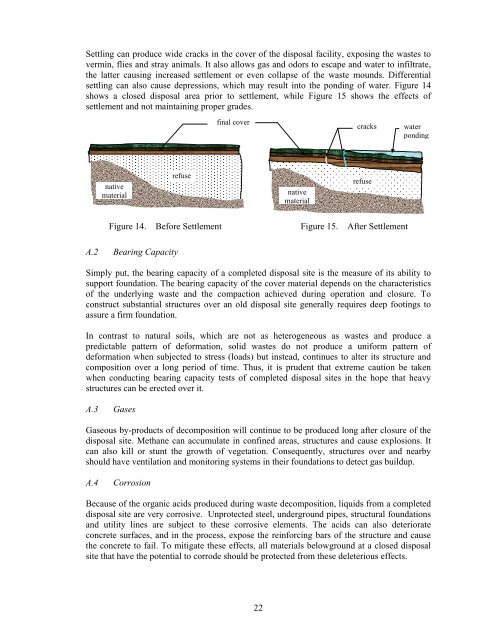Closing an Open Dumpsite and Shifting - International ...
Closing an Open Dumpsite and Shifting - International ...
Closing an Open Dumpsite and Shifting - International ...
Create successful ePaper yourself
Turn your PDF publications into a flip-book with our unique Google optimized e-Paper software.
Settling c<strong>an</strong> produce wide cracks in the cover of the disposal facility, exposing the wastes to<br />
vermin, flies <strong>an</strong>d stray <strong>an</strong>imals. It also allows gas <strong>an</strong>d odors to escape <strong>an</strong>d water to infiltrate,<br />
the latter causing increased settlement or even collapse of the waste mounds. Differential<br />
settling c<strong>an</strong> also cause depressions, which may result into the ponding of water. Figure 14<br />
shows a closed disposal area prior to settlement, while Figure 15 shows the effects of<br />
settlement <strong>an</strong>d not maintaining proper grades.<br />
native<br />
material<br />
Figure 14. Before Settlement Figure 15. After Settlement<br />
A.2 Bearing Capacity<br />
Simply put, the bearing capacity of a completed disposal site is the measure of its ability to<br />
support foundation. The bearing capacity of the cover material depends on the characteristics<br />
of the underlying waste <strong>an</strong>d the compaction achieved during operation <strong>an</strong>d closure. To<br />
construct subst<strong>an</strong>tial structures over <strong>an</strong> old disposal site generally requires deep footings to<br />
assure a firm foundation.<br />
In contrast to natural soils, which are not as heterogeneous as wastes <strong>an</strong>d produce a<br />
predictable pattern of deformation, solid wastes do not produce a uniform pattern of<br />
deformation when subjected to stress (loads) but instead, continues to alter its structure <strong>an</strong>d<br />
composition over a long period of time. Thus, it is prudent that extreme caution be taken<br />
when conducting bearing capacity tests of completed disposal sites in the hope that heavy<br />
structures c<strong>an</strong> be erected over it.<br />
A.3 Gases<br />
Gaseous by-products of decomposition will continue to be produced long after closure of the<br />
disposal site. Meth<strong>an</strong>e c<strong>an</strong> accumulate in confined areas, structures <strong>an</strong>d cause explosions. It<br />
c<strong>an</strong> also kill or stunt the growth of vegetation. Consequently, structures over <strong>an</strong>d nearby<br />
should have ventilation <strong>an</strong>d monitoring systems in their foundations to detect gas buildup.<br />
A.4 Corrosion<br />
refuse<br />
final cover<br />
Because of the org<strong>an</strong>ic acids produced during waste decomposition, liquids from a completed<br />
disposal site are very corrosive. Unprotected steel, underground pipes, structural foundations<br />
<strong>an</strong>d utility lines are subject to these corrosive elements. The acids c<strong>an</strong> also deteriorate<br />
concrete surfaces, <strong>an</strong>d in the process, expose the reinforcing bars of the structure <strong>an</strong>d cause<br />
the concrete to fail. To mitigate these effects, all materials belowground at a closed disposal<br />
site that have the potential to corrode should be protected from these deleterious effects.<br />
22<br />
native<br />
material<br />
cracks water<br />
ponding<br />
refuse

















